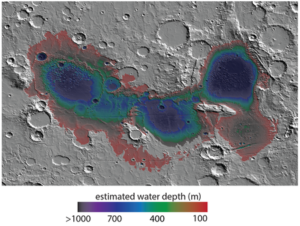HKU geologist’s discovery of early earth-like seafloor deposits on Mars could provide clues to life’s origins
Dr Joseph Michalski performing field work in a hydrothermal zone in Iceland.
Clues to life’s origins could be found in deposits that formed in the bottom of an ancient sea on Mars more than 3.8 billion years ago. Using infrared remote sensing, Dr Joseph Michalski, Associate Professor of the Department of Earth Sciences, and his colleagues have detected that minerals formed in a vast ancient Martian sea, larger than any land-locked sea on Earth, were similar to seafloor deposits found on early Earth billions of years ago. This groundbreaking work, published in Nature Communications, identifies a window into an environment where life potentially formed on Earth.
The oldest preserved rocks on Earth probably formed in a poorly understood ancient ocean. The presence of isotopically light carbon within biogenic morphologies in these rocks indicates that life may have flourished on the early Earth in hydrothermal seafloor environments. Yet progress in further understanding the actual origins of life or prebiotic chemistry from these rocks, or those of similar age, is severely challenged by the fact that they have experienced multiple generations of chemical over-printing and physical deformation. Because of this reality, studies of the ancient Earth might never reveal the origin of life.
The search for life’s origins through empirical geologic evidence might require exploration beyond Earth, where ancient rocks might still be preserved and younger geological activity has not overwritten critically important chemical and textural records. This journey could lead to Mars where the ancient sedimentary, volcanic and hydrothermal deposits contemporaneous with the origin of life on Earth have escaped deep burial and metamorphism.
On Earth, the seafloor contains minerals that form from the interaction of hot fluids from the crust with cold water in the bottom of the sea called hydrothermal seafloor deposits. Despite the lack of sunlight, these environments are teeming with life that thrives on chemical energy – the organisms live by eating rocks. It is not known how life on Earth formed, but some scientists think it might have originated in ancient seafloor environments through hydrothermal chemical reactions. Therefore, this well-reserved seafloor environment on Mars from billions of years ago could provide a window into the similar environments thought to have existed on the early Earth, which are not well-preserved here.
Dr Michalski and his colleagues discovered the deposits using infrared data from the Compact Reconnaissance Imaging Spectrometer for Mars (CRISM) instrument, a NASA experiment in orbit around Mars since 2006. CRISM is an infrared camera that can detect light in >500 wavelengths – most of them invisible to the human eye. By measuring the way infrared light reflects off of the Martian surface, it is possible to identify specific minerals on Mars because many minerals have a unique “fingerprint” in the infrared spectrum. In addition, the team also used remote sensing measurements of heat radiation, reflected lasers and high-resolution visible images to investigate the properties of the Martian surface.
“These deposits in the Eridania basin on Mars contain a unique set of rock textures and mineral occurrences that are not observed anywhere else on Mars,” said Michalski. “Ancient rocks like these are better preserved on Mars than on Earth because our planet has plate tectonics, which recycles the crust and Mars does not. These deposits therefore provide a window into the long lost geologic record of the early Earth.”
“In our quest to explore Mars, we are trying to understand the geology of our neighbouring planet and also to determine if the conditions for life occurred there. Previous work has shown that indeed there were environments on Mars where life could have existed. But this discovery is different. We have found a new category of geological conditions on ancient Mars. Not only would this sort of environment be habitable to life on Mars, it is the kind of environment where life is thought to have formed on Earth. Future exploration of this site will lead to a better understanding of the chemical environments that were present and hopefully pave a pathway toward a landed mission that could investigate – and perhaps sample – these materials on the Martian surface.”
Link of the article at Nature Communications:
https://www.nature.com/articles/ncomms15978
Personal webpage of Dr Joseph Michalski: https://www.clays.space

An image of Mars from the Hubble Space Telescope. The Eridania region is located in the lower right part of the disk. (Photo courtesy: NASA)

The gray image is a topographic map of Mars. The colorized parts show an estimate of the minimum size of the Eridania sea with estimated depths based on elevation data. The Eridania basin would have been >1500 km across and > 1 km water depth. (Photo courtesy: Nature Communications)

A high-resolution false colour image shows the ancient seafloor deposits up close. The network of cross-cutting veins formed from fluids in the rocks. The green-yellow-brown deposits are composed of Fe- and Mg-rich clay minerals that formed at the base of a deep sea. This image is approximate 1 km across. (Photo courtesy: NASA/JPL/University of Arizona)


